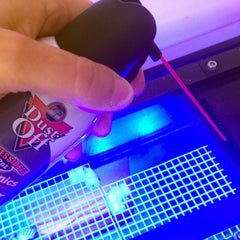Tuesday Tech Tips - How to Care for your LED Lights
 You've made the switch to LED lights from power compacts, T5 or Metal Halides.... great! Now you don't have to change your bulbs every year and you are probably seeing huge savings on your electric bill! However the plug and play simplicity of LED lights doesn't mean that you can ignore them after installation. Treat your LED lights as you would any other piece of sensitive electronic equipment. While most LED lights have been tested in salt water conditions, they still require some help from the user to keep them functioning properly. To ensure that your LED aquarium lights stay in top working condition, we recommend the following maintenance tips.
You've made the switch to LED lights from power compacts, T5 or Metal Halides.... great! Now you don't have to change your bulbs every year and you are probably seeing huge savings on your electric bill! However the plug and play simplicity of LED lights doesn't mean that you can ignore them after installation. Treat your LED lights as you would any other piece of sensitive electronic equipment. While most LED lights have been tested in salt water conditions, they still require some help from the user to keep them functioning properly. To ensure that your LED aquarium lights stay in top working condition, we recommend the following maintenance tips.
 Salt creep and salt spray can affect your lights, and if left uncleaned, can cause serious problems with the fans, circuitry, LED diodes, lenses and more. Be sure to wipe down the exterior of your lights with a clean, damp (not wet) cloth at least once per month or more frequently. Be sure to wipe any salt spray from the lenses to make sure the light is not being hindered. Also, wipe the exterior housing of the lights and be sure to inspect the power cords and any controller or sync cables for slat creep. Follow up with a clean, dry towel to make sure you remove any excess moisture.
Salt creep and salt spray can affect your lights, and if left uncleaned, can cause serious problems with the fans, circuitry, LED diodes, lenses and more. Be sure to wipe down the exterior of your lights with a clean, damp (not wet) cloth at least once per month or more frequently. Be sure to wipe any salt spray from the lenses to make sure the light is not being hindered. Also, wipe the exterior housing of the lights and be sure to inspect the power cords and any controller or sync cables for slat creep. Follow up with a clean, dry towel to make sure you remove any excess moisture.
 Next, you'll want to make sure you keep the dust from clogging the ventilation slots and cooling fans. Use a can of compressed air and blast out any accumulated dust. This will also help keep the electronics inside dust free and functioning properly. A can of inexpensive compressed air can be purchased at your local home improvement store.
Next, you'll want to make sure you keep the dust from clogging the ventilation slots and cooling fans. Use a can of compressed air and blast out any accumulated dust. This will also help keep the electronics inside dust free and functioning properly. A can of inexpensive compressed air can be purchased at your local home improvement store.
 Now you should visually inspect the LED diodes and the cables to be sure everything is working properly and that there are no loose connections. If you notice any frayed or kinked wires, check to make sure there are no shorts. If there are shorts, order a replacement cable.
Now you should visually inspect the LED diodes and the cables to be sure everything is working properly and that there are no loose connections. If you notice any frayed or kinked wires, check to make sure there are no shorts. If there are shorts, order a replacement cable.
 The last thing we recommend doing is to check all the programming to be sure the LED and the controller are functioning properly. Many LEDs have built in controllers or have separate controllers that connect via blue tooth, wi-fi or cables. Take a few minutes to run the lights through their programmed schedule to make sure the controller and the LED light fixture are communicating properly and that the programmed light schedule is functioning as intended.
The last thing we recommend doing is to check all the programming to be sure the LED and the controller are functioning properly. Many LEDs have built in controllers or have separate controllers that connect via blue tooth, wi-fi or cables. Take a few minutes to run the lights through their programmed schedule to make sure the controller and the LED light fixture are communicating properly and that the programmed light schedule is functioning as intended.
